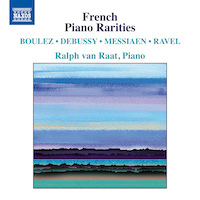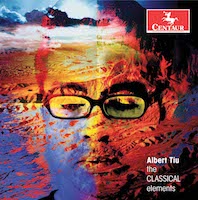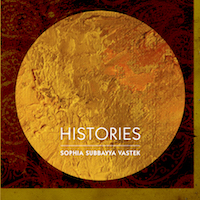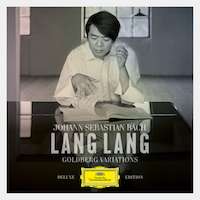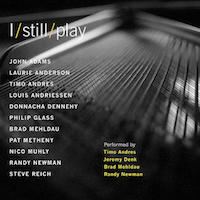Piano Factory 27.
|
Grant Chu Covell [January 2021.]
“French Piano Rarities.” Claude DEBUSSY: Étude retrouvée (1915); Les Soirs illuminés par l’ardeur du charbon (1917). Olivier MESSIAEN: Morceau de lecture à vue (1934); Le Cossyphe d’Heuglin and Le Moqueur polyglotte from Des canyons aux étoiles… (1974); La Fauvette passerinette (1961). Pierre BOULEZ: Prélude, Toccata et Scherzo (1944); 12 Notations (1945); Une page d’éphéméride (2005). Maurice RAVEL: Menuet (1904). Ralph van Raat (pno). Naxos 8. 8573894 (1 CD) (www.naxos.com). Van Raat wraps unfamiliar French piano music around a Boulez premiere. Doing so humanizes Boulez agreeably, as if to say “Le Maître avec Marteaux” is the last French Romantic Master. The Debussy Étude retrouvée is the first crack at what became Étude 11 pour les arpèges composés and Les Soirs illuminés par l’ardeur du charbon was written to thank the coal merchant who kept his family well supplied during WWI. These Messiaen pieces revel in voluptuous chords, jarring rhythms and birdsongs, contrasting raw nature against Debussy’s suave scales and oblique harmony. We should focus upon the Boulez triptych, written at 19, whose aggressiveness could be mistaken for Ornstein or Bartók, but van Raat draws forth a cultured warmth and harmonies heard in Messiaen’s classes. A giant step away, the pithy and somewhat dodecaphonic Notations from the subsequent year, are even more convincing as a masterpiece. Like the Ligeti Études, Boulez’ Notations are starting to appear everywhere. Sixty years after Notations comes Une page d’éphéméride, sectional, easier to digest, but still Romantic in a pouncing sweep. The subsequent Ravel Menuet, like Debussy’s piece lit by coal, completes the frame.
“The Classical Elements.” Franz LISZT: Waldesrauschen from Two Concert Etudes, S145 (1893); Les jeux d’eau à la Villa d’Este from Années de pèlerinage, 3rd year, S163 (1877). Leopold GODOWSKY: The Gardens of Buitenzorg from Java Suite (1925). Sergey RACHMANINOV: Lilacs, No. 5 from 12 Songs, Op. 21 (1902/13). Claude DEBUSSY: Les collines d’Anacapri, Le vent dans la plaine, and Reflets dans l’eau from Préludes, Book 1 (1910); Feux d’artifice from Préludes, Book 2 (1913). Luciano BERIO: Erdenklavier (1969), Luftklavier (1985), Wasserklavier (1965), and Feuerklavier (1989) from Six Encores. Charles GRIFFES: The Night Winds from Three Tone-Pictures, Op. 5 (1915). Jacques IBERT: Le vent dans les ruines (1915). Olivier MESSIAEN: Un reflet dans le vent from 8 Préludes (1929). Federico MOMPOU: El lago from Paisajes (1947). Maurice RAVEL: Jeux d’eau (1901). Richard WAGNER: Feuerzauber from Die Walküre (1865; arr. Louis BRASSIN, 1877). Alexander SCRIABIN: Vers la flamme, Op. 72 (1914). Manuel DE FALLA: Danza ritual del fuego from El amor brujo (1915/21). Albert Tiu (pno). Centaur Records CRC 3503 (1 CD) (www.centaurrecords.com). Tiu is an exciting Romantic player. This program offers twenty pieces grouped in fives for each of the Classical elements: earth, air, water and fire. The emphasis is on turn-of-the-century works with nods to composer-pianists (Liszt, Rachmaninoff, Griffes, Ibert, Scriabin). Each quintet includes a work by Debussy and Berio. The fantastic Waldesrauschen by Liszt sets the tone, and the recurring Debussy Préludes anchor the arrangement. We can hear how Berio’s piano encores were influenced by Debussy, if not by specific compositions then by their expressive gestures. Tiu should definitely set down more Liszt and Debussy; Ravel’s Jeux d’eau is impressively fine. The fire quintet is the most awkward: Outside of the exciting Scriabin, the Wagner and de Falla transcriptions aren’t as thrilling.
“Histories.” Michael HARRISON: Jaunpuri (2015)1; Hijaz Prelude (2011)2. John CAGE: She is Asleep (1943)3; Dream (1948)4; A Room (1943)5. Donnacha DENNEHY: Stainless Staining (2007)6. Sophia Subbayya Vastek1,2,3,4,5,6 (pno), Michael Harrison1,2 (tanpura), Nitin Mitta1,2 (tabla), Megan Schubert3 (voice). Innova 974 (1 CD) (www.innova.mu). This smart program appears to begin in one place and end in another. Cage’s experimental meandering anchors throughout but is hardly the focus. Harrison’s trios, inviting combinations of piano, tanpura and tabla, establish a human scale and are counteracted by the icy exactness of Dennehy’s Stainless Staining for piano and tape. Both Harrison works ask for the piano to be tuned in just intonation; some of the Cage is prepared. Jaunpuri is based on a vocal composition (bandash) and uses the jaunpuri raga. The Hijaz Prelude uses the hijaz mode, a keyboard figuration familiar from Bach’s WTC I and a structure inspired by Pärt. Stainless Staining is a tightly choregraphed sequence of loops exploring overtones derived from a G# fundamental layered over an insistent pulse derived from detuned piano sounds and perhaps percussion. (I also hear a nod to Ferrari’s Programme commun and Cellule 75.) Appearing three times in different registers, Cage’s Dream reflects Satie, however, contrasting Harrison’s ragas, Cage faces westward. She is Asleep for wordless voice and prepared piano is at best an oddity. If it felt incomplete in its day (it was to be programmed with A Room for prepared piano), it is tolerated now because of Cage’s prestige.
J.S. BACH: Goldberg Variations, BWV 988 (1741). Lang Lang (pno). Deutsche Grammophon DG 481 9701 (4 CDs) (www.deutschegrammophon.com). No recording can be perfect if you choose to listen closely, but Lang Lang’s Goldbergs are whimsical and terrible. Starting with the initial Aria, the wunderkind appears unwilling to execute any two successive measures in tempo. Rubato is of course permissible, but Lang Lang’s wandering serves no meaningful expressive purpose except to say the pianist has so many feelings. Likewise, ornaments appear in repeats which rebuff Baroque sensibilities, and concurrent voices are sloppily played. The canons are the worst of the lot: If Lang Lang were to paint roadway lines, they would weave and cross, and the streets would be littered with totaled cars. Lang Lang prefers to probe Bach’s “dark side” rather than technically execute counterpoint and let the music speak for itself. Now and again, there are glimmers at how fine this could be, such as Var. 13 in the studio recording, but then Lang Lang’s expressive dynamics waver drunkenly, or the repeat’s articulations confound with their arbitrariness. In the studio recording, Var. 25 is a prime example of tempos decelerating to hopelessness, and the Aria’s reprise is sickly slack. This release pairs a March 2020 studio performance with a live concert given at Thomaskirche just days before. To think Lang Lang was in that exalted place playing so wantonly! Having sustained the studio version first, I was acclimatized to Lang Lang’s nuttiness, which still startled in the set made in Bach’s home turf, although, I find the live spectacle preferable if I had to choose. Streaming services offer extra takes.
“I Still Play.” Nico MUHLY: Move (2017)1. Timo ANDRES: Wise Words (2017)2. Louis ANDRIESSEN: Rimsky or La Monte Young (2017)3. John ADAMS: I Still Play (Pocket Variations) (2017)4. Philip GLASS: Evening Song No. 2 (2017)5. Laurie ANDERSON: Song for Bob (2017)6. Brad MEHLDAU: L.A. Pastorale (2017)7. Steve REICH: For Bob (2017)8. Pat METHENY: 42 Years (2017)9. Donnacha DENNEHY: Her Wits (About Him) (2017)10. Randy NEWMAN: Recessional (2017)11. Timo Andres1,2,3,5,6,8,10, Jeremy Denk4, Brad Mehldau7,9, Randy Newman11 (pno). Nonesuch 075597920864 (1 CD) (www.nonesuch.com). I am happy to celebrate the tenure of Nonesuch leader Bob Hurwitz. These works celebrate his retirement after 32 years, and were written specifically for his intermediate keyboard skills. However, I feel bad being lukewarm about a fantastic idea, but I don’t see many of these homages finding life outside of this festschrift. Considering the full program, Glass’ contribution reminds us that he stands alone: The preceding four pale in comparison. Even the Andriessen is a mindless tease, a five-finger study which circles the drain before departing. And after the Glass, whether Laurie Anderson or Pat Metheny, the works fuse into a tepid drizzle.
Adams, Andres, Andriessen, Bach, Berio, Boulez, Brassin, Cage, De Falla, Debussy, Dennehy, Glass, Godowsky, Griffes, Ibert, Laurie Anderson, Liszt, M Harrison, Mehldau, Messiaen, Metheny, Mompou, Muhly, R Newman, Rachmaninov, Ravel, Reich, Scriabin, Wagner
[More Grant Chu Covell, Piano Factory]
[More
Adams, Andres, Andriessen, Bach, Berio, Boulez, Brassin, Cage, De Falla, Debussy, Dennehy, Glass, Godowsky, Griffes, Ibert, Laurie Anderson, Liszt, M Harrison, Mehldau, Messiaen, Metheny, Mompou, Muhly, R Newman, Rachmaninov, Ravel, Reich, Scriabin, Wagner]
[Previous Article:
String Theory 35: Mostly Guitars]
[Next Article:
(Dis)Arrangements 12: Winterreisen]
|
